The night Edinburgh's skyline glowed orange
- Published
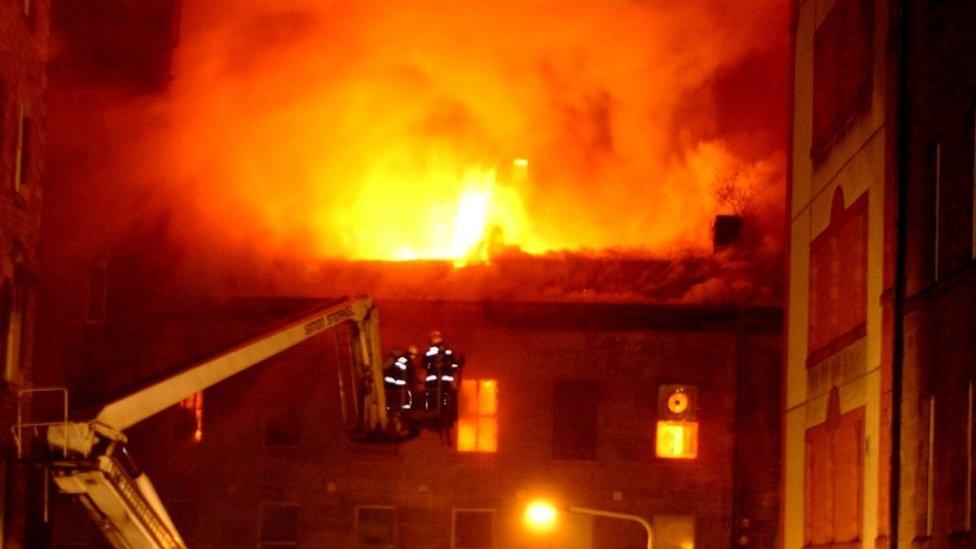
Looking down at the Cowgate from Blair Street on the night of the fire in 2002
It was Edinburgh's worst fire in living memory and took more than 15 hours to bring under control.
The Cowgate fire on 7 December 2002 needed more than 80 firefighters to put it out. At its height it threatened to spread across the city's historic Old Town.
In its wake, one of Edinburgh's most vibrant arts quarters was destroyed and a huge scar was left in the city centre that took more than a decade to heal.
Edinburgh's Cowgate has long been a chaotic and polluted street where every inch of space is surrendered to stone and asphalt.
It's not a landscape that features in many postcards of the city but in 2002 this unpolished part of the Old Town was its brightest spot for the arts and entertainment.
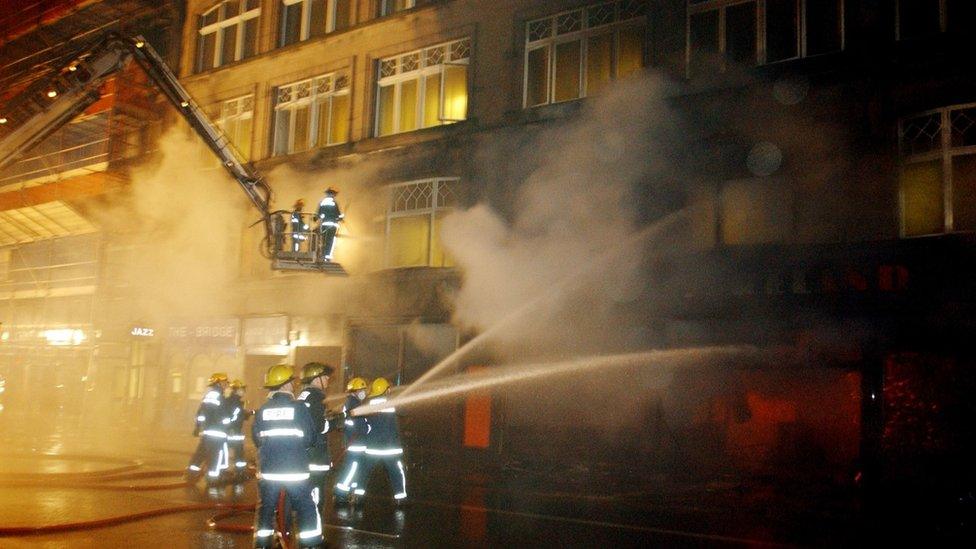
The fire spread to buildings in Edinburgh's Cowgate, Chambers Street and South Bridge
The Cowgate fire, as it became known, took hold in a complex of 11 buildings where bars, nightclubs, artists' studios, university offices and a comedy club were all mashed together over eight wonky floors.
This bewildering configuration meant that on the night two separate incidents were initially called in to Lothian and Borders Fire and Rescue Service.
The first call reported smoke in the Leisureland amusement arcade on South Bridge, the street which dissects and towers above the Cowgate. Smoke was also seen in the Living Room pub on the Cowgate.
As the pub's customers were asked to head out into the cold December night, there was no immediate sense of the chaos that was shortly to follow.
But that changed when the fire crew sent to Leisureland hacked a hole into the side of a stairwell connecting the two sites to reveal an old lift shaft where the blaze was advancing the full height of the building.

Firefighters stayed on the scene for days after the blaze broke out to ensure it was fully extinguished
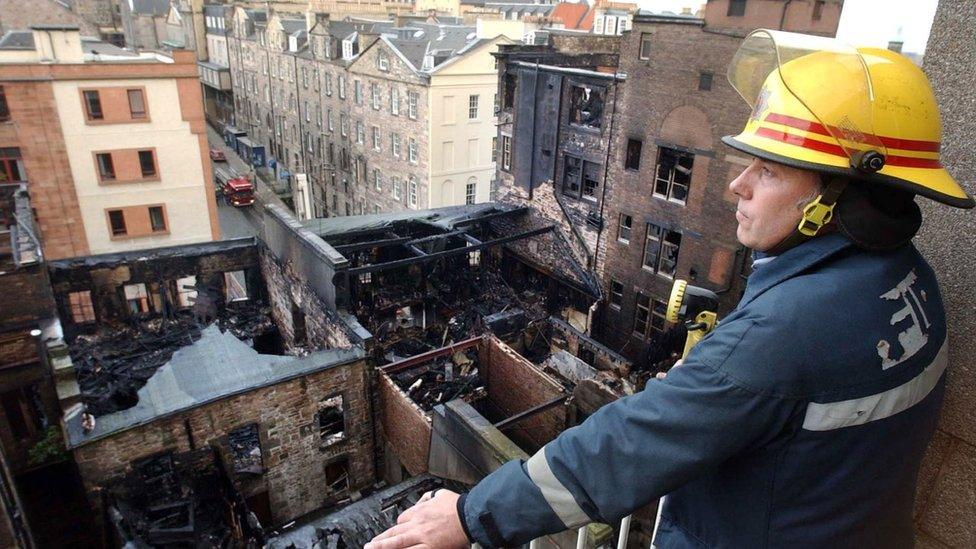
A firefighter surveys the remains of the site looking towards the Cowgate and Blair Street
"We now knew it was one big fire, not two, and had to regroup," explains Frank White, who was assistant divisional officer for Lothian and Borders Fire Brigade in 2002.
"It was a nightmare - smoke from all directions and these labyrinth-like spaces with no real sense of where you were for the firefighters at the front.
"There's actually little of the Old Town that's not a nightmare, but this site was probably one of the worst. All these buildings all thrown together, and we were finding out just how chaotic it was in real time."
Frank was there on the night, and was also part of the team that later investigated the fire
"Because, thankfully, nobody was killed or seriously injured, I don't think people are really aware of how serious this fire was and how close we got to it taking hold across an ever bigger section of the Old Town.
"It was bad, but in many ways the Old Town had a lucky escape."

'What on earth am I going to do'
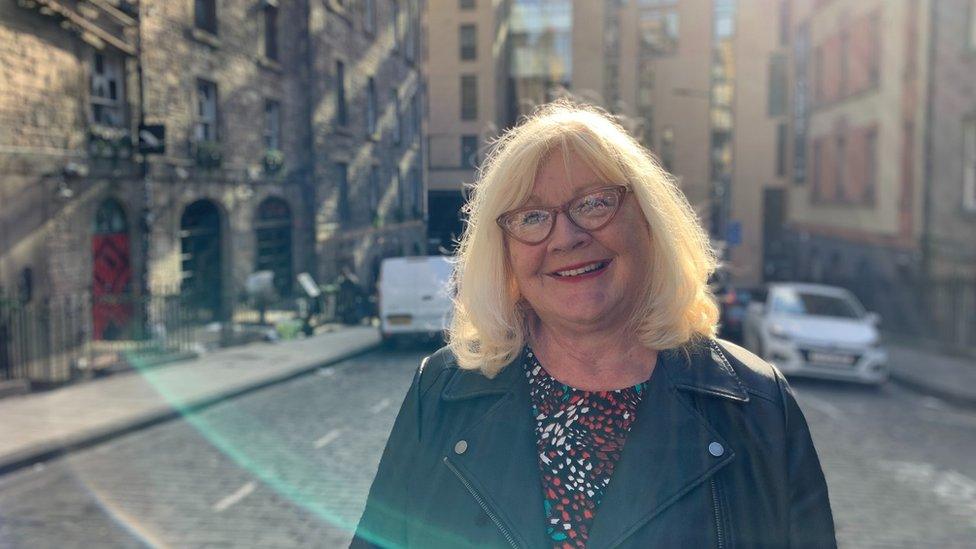
Comedy club promoter Karen Koren with what was the Cowgate fire site in the background
The Gilded Balloon comedy club was at the heart of the Cowgate complex and a central plank of the Edinburgh Fringe since the late 1980s, helping to launch the careers of the likes of Steve Coogan and Russell Brand.
Owner Karen Koren was driving home from meeting her new-born granddaughter when she got the call about the fire.
"My heart just sank," she says.
"From my house you can see over the whole of Edinburgh and when I got home you could see the red light. Everybody I knew started phoning me.
"It was a spectacle, people were watching it burn, but I couldn't bring myself to go until the next morning."
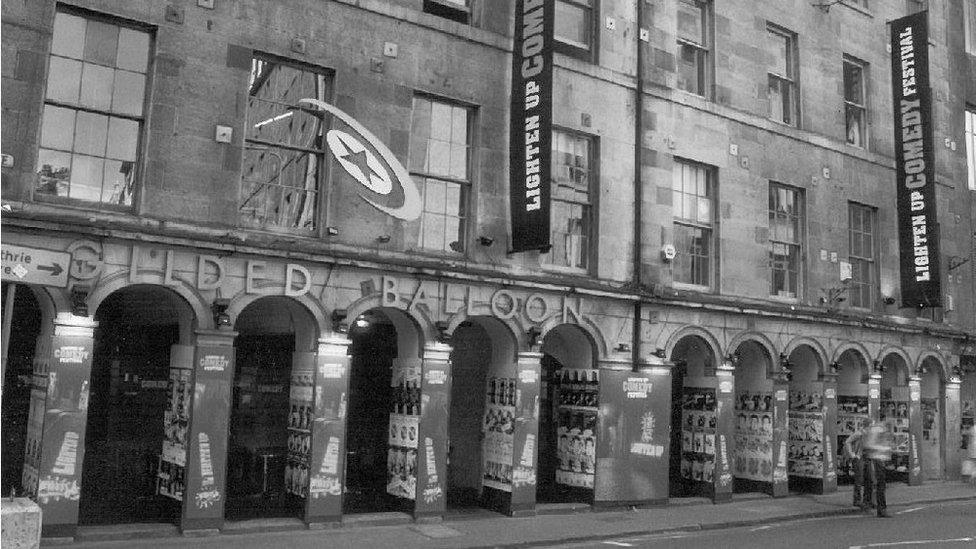
The Gilded Balloon in the late 1990s when it was a key part of the city's arts scene
All that Karen could retrieve from the shell of the club was some old photos.
But the Gilded Balloon had expanded into another venue, Teviot Row, a few months before the fire, so they were able to rebuild the business from there.
Karen says that when her business had to close overnight due to the Covid pandemic lockdown, it took her back to that moment in 2002.
"It was devastating. I had built up that business on my own and it was a bit like when Covid started - it gave me that reminder of that 'what on earth am I going to do' moment.
"But I was determined we'd be back."

Much of the fire site had been part of the J and R Allan department store. It closed in the late 1970s and the building was divided up over time, with sections in effect removed from certifiable use and fire certificates amended accordingly.
Parcelling up the old department store also meant the sprinkler system installed by J and R Allan had long been abandoned.
"Those areas that had been sealed off from the original building now formed these sizeable void areas through which service ducts, cables and all sorts ran," says Frank.
"They were these effectively unofficial spaces, neither really part of the building or the outside world.
"The old lift shaft was where the focus was - someone got a hatch above the Living Room pub open and that settled exactly where the fire was coming from, but of course it was spreading rapidly now.
"You're in constant radio contact with the firefighters at the front and you pick up on the changes in their pitch and tone, it was clearly getting more dangerous."
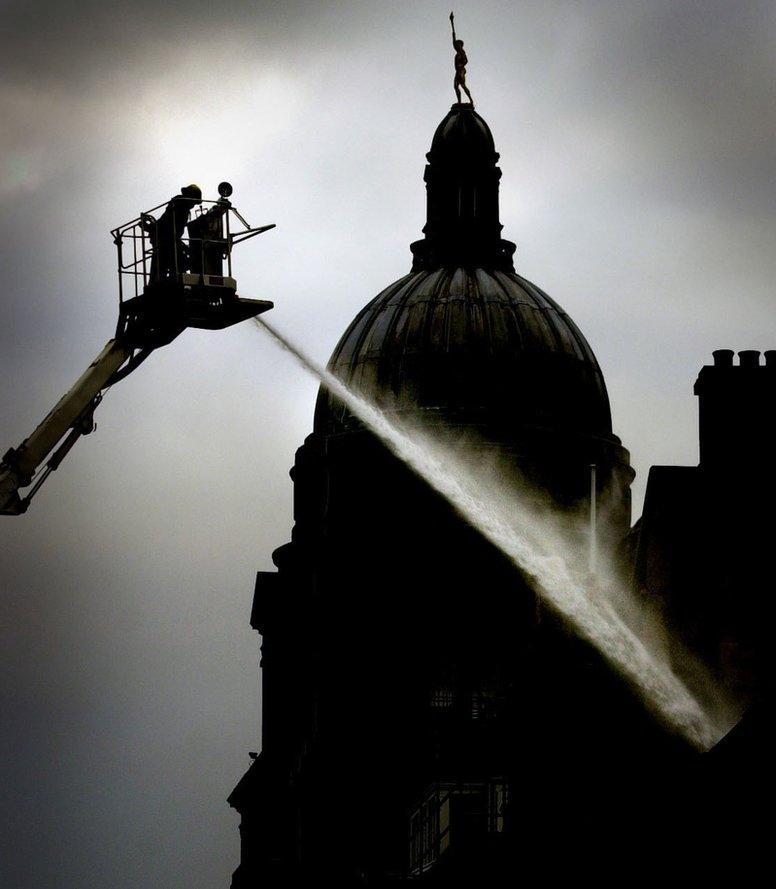
The dome of University of Edinburgh's Old College in the background as firefighters continue to dampen the Cowgate fire the day after the blaze broke out. The Old College escaped damage but the university's School of Informatics was badly damaged with thousands of books destroyed
The intensity of the blaze, spurred on by raw winds whipped in from the Firth of Forth, meant pillars of fire leapt 60ft in the air and danced over the slate roofs of neighbouring buildings.
It was Sunday morning by the time the blaze was regarded as under control, about 15 hours after the first call came in.
But firefighters were on the scene for days to ensure there were no hidden fires in the voids.
In the days after the fire it became clear that the site would have to be bulldozed and the subsequent fire service investigation was hampered by the fact it was too dangerous to inspect some areas.
As a result, Lothian and Borders Fire Brigade ruled the cause was likely to have been a faulty fuse box, tucked inside a void, in the disused department store's lift shaft.
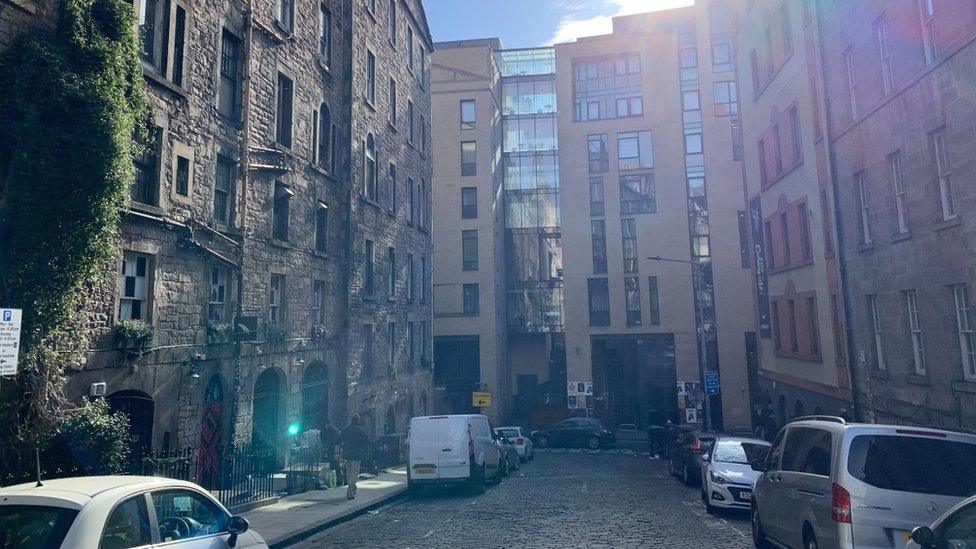
The site was finally reopened 12 years after the fire struck with a £35m complex of hotels, shops and a nightclub
"We were undone by these voids, both on the night and in the investigation after," adds Frank.
"Because the damage was so extensive and we couldn't get into the places we wanted to, it was essentially our best educated guess."
There was little that could be saved from the site and demolition work left a huge hole in the Cowgate that took more than a decade to fill.
With so many different land owners and lying in a World Heritage Site, the wrangling over the fire site's future was lengthy - but in 2014, a £35m hotel and shops complex opened.
The only link to the site's previous life was the reopening of the La Belle Angele nightclub - which held legendary drum and bass club Manga - in virtually the same location the venue was in before the fire.

'It took years to recover'
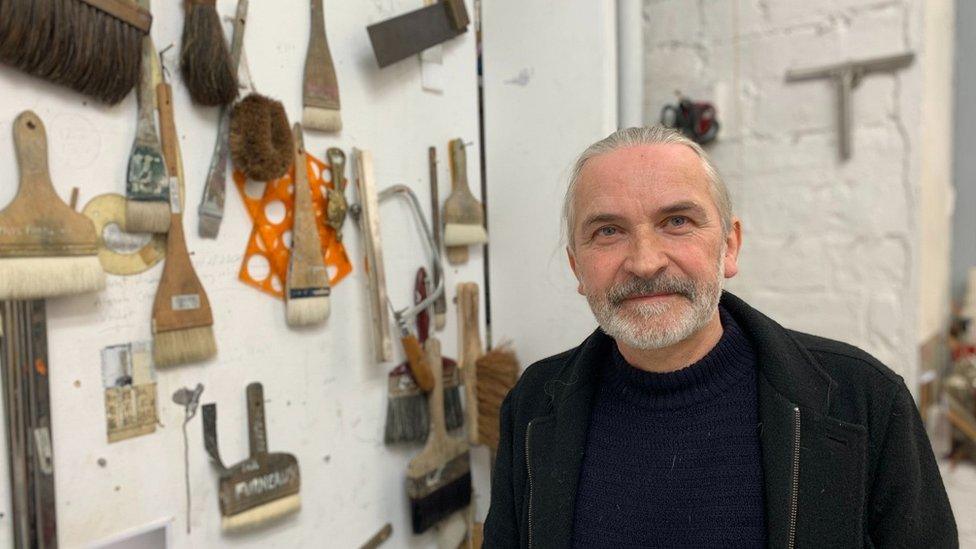
Paul Furneaux has exhibited his Japanese woodblock printing all over the world
Riding high in the Scottish art scene, Paul Furneaux had just finished a year as artist in residence at the National Museum of Scotland when the fire destroyed his Cowgate studio.
It meant 15 years' worth of materials, equipment and work were gone.
The printmaking artist was at a party when heard the news of the blaze on the radio and made his way over to the Cowgate.
"We looked down and where my studio was I could see flames still coming out of the building," he says.
"I didn't cry but I felt so low. I had insisted if there was anything salvageable I wanted it, but I think that was a mistake; I got some things back but they were all charcoaled and it was upsetting."
In the week after the fire Paul said he would wake up every morning "utterly exhausted" from vivid dreams about his lost work.
He added: "It was like going through draw by draw, mentally digesting everything in the hundreds of things that were gone - reliving the emotions of making the work."
Paul says the time he did cry was when the now defunct Scottish Arts Council turned him down for a £2,000 grant as he was trying to restart. He slipped into a depression that lasted "not months but years" after the fire.
Friends and family rallied round. Paul eventually got a new studio and tools, and since then he has won a series of awards and been invited to exhibit his Japanese woodblock printing internationally.